Dual-Polarized Metal Vivaldi Array Using Independent Structural Elements
Abstract
1. Introduction
2. Antenna Element Design and Analysis
2.1. Antenna Element Design
2.2. Manufacturing Factor Analysis
2.3. Resonance-Suppression Method
3. Manufacturing of Dual-Polarized Element
4. Experimental Results
5. Conclusions
Author Contributions
Funding
Institutional Review Board Statement
Informed Consent Statement
Data Availability Statement
Conflicts of Interest
References
- Li, R.; Li, P.; Rocca, P.; Salas Sánchez, A.Á.; Song, L.; Li, X.; Xu, W.; Fan, Z. Design of Wideband High-Gain Patch Antenna Array for High-Temperature Applications. Sensors 2023, 23, 3821. [Google Scholar] [CrossRef]
- Li, Q.; Nie, C.; Liu, Z.; Zhou, X.; Cheng, X.; Liang, S.; Yao, Y. Circularly Polarized Ultra-Wideband Antenna for Uni-Traveling-Carrier Photodiode Terahertz Source. Sensors 2023, 23, 9398. [Google Scholar] [CrossRef]
- Lu, P.; Liu, Z.; Lei, E.; Huang, K.; Song, C. Superdirective Wideband Array of Circular Monopoles with Loaded Patches for Wireless Communications. Sensors 2023, 23, 7851. [Google Scholar] [CrossRef]
- Ding, G.; Li, P.; Rocca, P.; Chang, J.; Xu, W. Surrogate-Model-Based Interval Analysis of Spherical Conformal Array Antenna with Power Pattern Tolerance. Sensors 2022, 22, 9828. [Google Scholar] [CrossRef]
- Li, P.; Liu, W.G.; Ren, Z.M.; Meng, W.J.; Song, L.W. A High-Temperature and Frequency-Reconfigurable Multilayer Frequency Selective Surface Using Liquid Metal. IEEE Access 2022, 10, 9446–9454. [Google Scholar] [CrossRef]
- Gibson, P.J. The Vivaldi aerial. In Proceedings of the 9th European Microwave Conference, Brighton, UK, 17–20 September 1979; pp. 101–105. [Google Scholar]
- Schaubert, D.H.; Kasturi, S.; Boryssenko, A.O.; Elsallal, W.M. Vivaldi antenna arrays for wide bandwidth and electronic scanning. In Proceedings of the Second European Conference on Antennas and Propagation (EuCAP), Edinburgh, UK, 11–16 November 2007; pp. 1–6. [Google Scholar]
- Yao, Y.; Liu, M.; Chen, W.; Feng, Z. Analysis and design of wideband widescan planar tapered slot antenna array. IET Microw. Antenna Propag. 2010, 4, 1632–1638. [Google Scholar] [CrossRef]
- Langley, J.; Hall, P.; Newham, P. Balanced antipodal Vivaldi antenna for wide bandwidth phased arrays. IEE Proc. Microw. Antennas Propag. 1996, 143, 97–102. [Google Scholar] [CrossRef]
- Chio, T.H.; Schaubert, D.H. Parameter Study and design of wide-band widescan dual-polarized tapered slot antenna arrays. IEEE Trans. Antennas Propag. 2010, 48, 879–886. [Google Scholar] [CrossRef]
- Holter, H.; Chio, T.H.; Schaubert, D.H. Experimental results of 144-element dual-polarized endfire tapered-slot phased arrays. IEEE Trans. Antennas Propag. 2000, 48, 1707–1718. [Google Scholar] [CrossRef]
- Yngvesson, K.S.; Schaubert, D.H.; Korzeniowski, T.L.; Kollberg, E.L.; Thungren, T.; Johansson, J.F. Endfire tapered slot antennas on dielectric substrates. IEEE Trans. Antennas Propag. 1985, 33, 1392–1400. [Google Scholar]
- Hood, A.Z.; Karacolak, T.; Topsakal, E. A small antipodal Vivaldi antenna for ultrawide-band applications. IEEE Antennas Wirel. Propag. Lett. 2008, 7, 656–660. [Google Scholar] [CrossRef]
- Pfeiffer, C.; Steffen, T.; Phillips, G.; Tomasic, B. High power AESAs for 20–60 GHz with linear and circular polarizations. In Proceedings of the IEEE International Symposium on Phased Array System & Technology (PAST), Waltham, MA, USA, 15–18 October 2019. [Google Scholar]
- Kahkonen, H.; Ala-Laurinaho, J.; Viikari, V. Dual-polarized Ka-band Vivaldi antenna array. IEEE Trans. Antennas Propag. 2020, 68, 2675–2683. [Google Scholar] [CrossRef]
- Sapari, L.; Hout, S.; Chung, J.-Y. Brain Implantable End-Fire Antenna with Enhanced Gain and Bandwidth. Sensors 2022, 22, 4328. [Google Scholar] [CrossRef] [PubMed]
- Slimi, M.; Jmai, B.; Dinis, H.; Gharsallah, A.; Mendes, P.M. Metamaterial Vivaldi Antenna Array for Breast Cancer Detection. Sensors 2022, 22, 3945. [Google Scholar] [CrossRef] [PubMed]
- Kindt, R.W.; Pickles, W.R. Ultrawideband all-metal flared-notch array radiator. IEEE Trans. Antennas Propag. 2010, 58, 3568–3575. [Google Scholar] [CrossRef]
- Kindt, R.W.; Logan, J.T.; Elsallal, M.W. Machined Metal FUSE Array Apertures. In Proceedings of the IEEE International Symposium on Phased Array System & Technology (PAST), Waltham, MA, USA, 15–18 October 2019. [Google Scholar]
- Kindt, R.W.; Logan, J.T. Dual-polarized metal-flare sliced notch antenna array. IEEE Trans. Antennas Propag. 2020, 68, 2666–2674. [Google Scholar] [CrossRef]
- Yan, J.; Gogineni, S.; Camps-Raga, B.; Brozena, J. A Dual-Polarized 2–18-GHz Vivaldi Array for Airborne Radar Measurements of Snow. IEEE Trans. Antennas Propag. 2022, 21, 9–13. [Google Scholar] [CrossRef]
- Kedar, A. Dielectric Free Wide Scan UWB Low Cross-Pol Metallic Vivaldi Antenna for Active Phased Array Radars. IETE J. Res. 2022, 68, 602–610. [Google Scholar] [CrossRef]
- Kahkonen, H.; Ala-Laurinaho, J.; Viikari, V. A Modular Dual-Polarized Ka-Band Vivaldi Antenna Array. IEEE Access 2022, 10, 36362–36372. [Google Scholar] [CrossRef]
- Pfeiffer, C.; Massman, J.; Steffen, T. 3-D Printed Metallic Dual-Polarized Vivaldi Arrays on Square and Triangular Lattices. IEEE Trans. Antennas Propag. 2021, 69, 8325–8334. [Google Scholar] [CrossRef]
- Kahkonen, H.; Proper, S.; Ala-Laurinaho, J.; Viikari, V. Comparison of Additively Manufactured and Machined Antenna Array Performance at Ka-Band. IEEE Antennas Wirel. Propag. Lett. 2022, 21, 9–13. [Google Scholar] [CrossRef]
- Haarla, J.; Ala-Laurinaho, J.; Viikari, V. Scalable 3-D-Printable Antenna Array With Liquid Cooling for 28 GHz. IEEE Trans. Antennas Propag. 2023, 71, 5067–5078. [Google Scholar] [CrossRef]
- Li, Y.; Li, X.; Tao, J.; Liu, C. Modular All Metal Vivaldi Antenna With 9:1 Bandwidth. In Proceedings of the 2022 Cross Strait Radio Science & Wireless Technology Conference (CSRSWTC), Beijing, China, 17–18 December 2022; pp. 1–3. [Google Scholar]
- Mailloux, R. Phased Array Antenna Handbook, 2nd ed.; Artech House Inc.: Norwood, MA, USA, 2001. [Google Scholar]
- Harrinton, R.F. Harmonic Electromagnetic Fields, Electrical and Electronic Engineering Series; McGraw-Hill: New York, NY, USA, 1961. [Google Scholar]
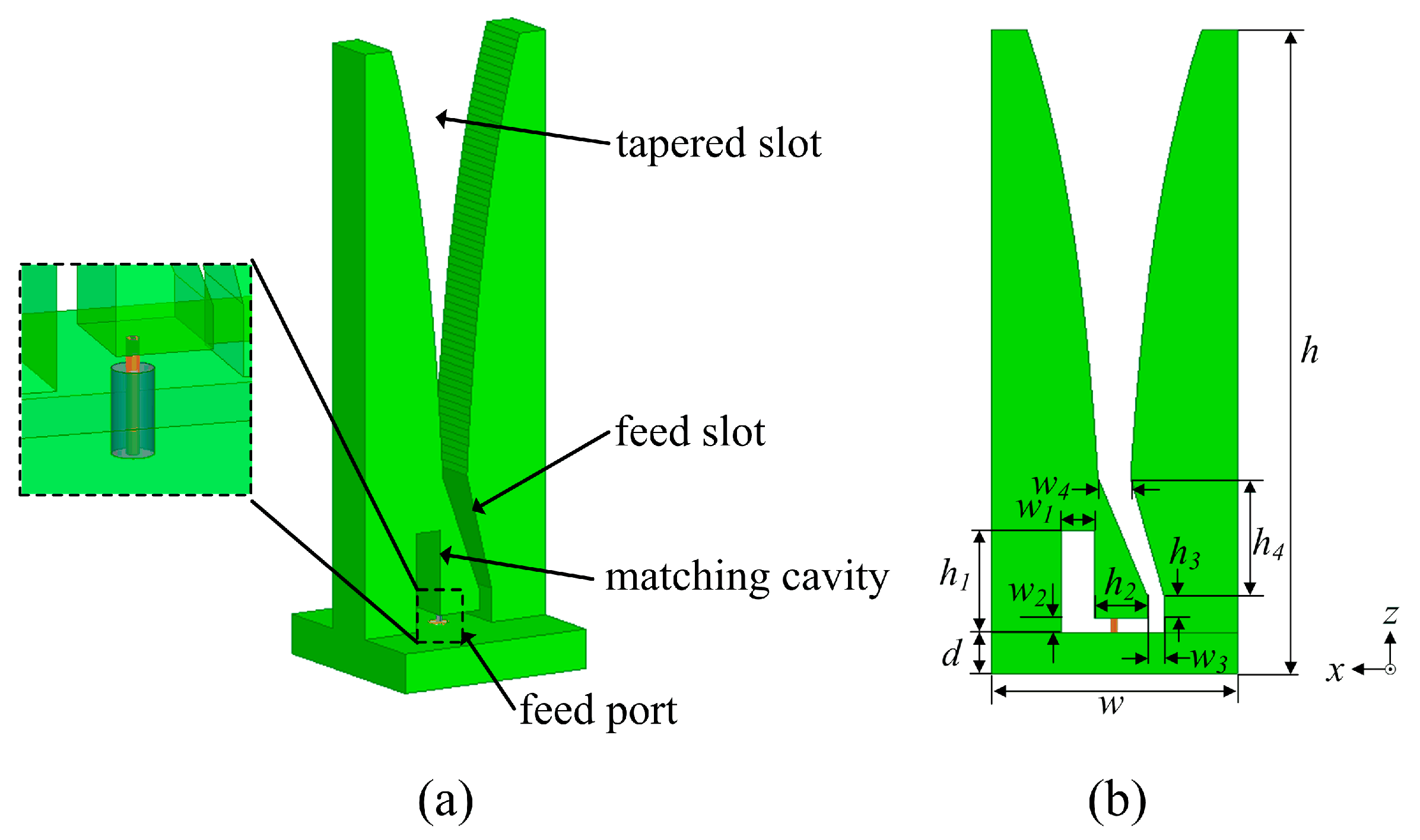


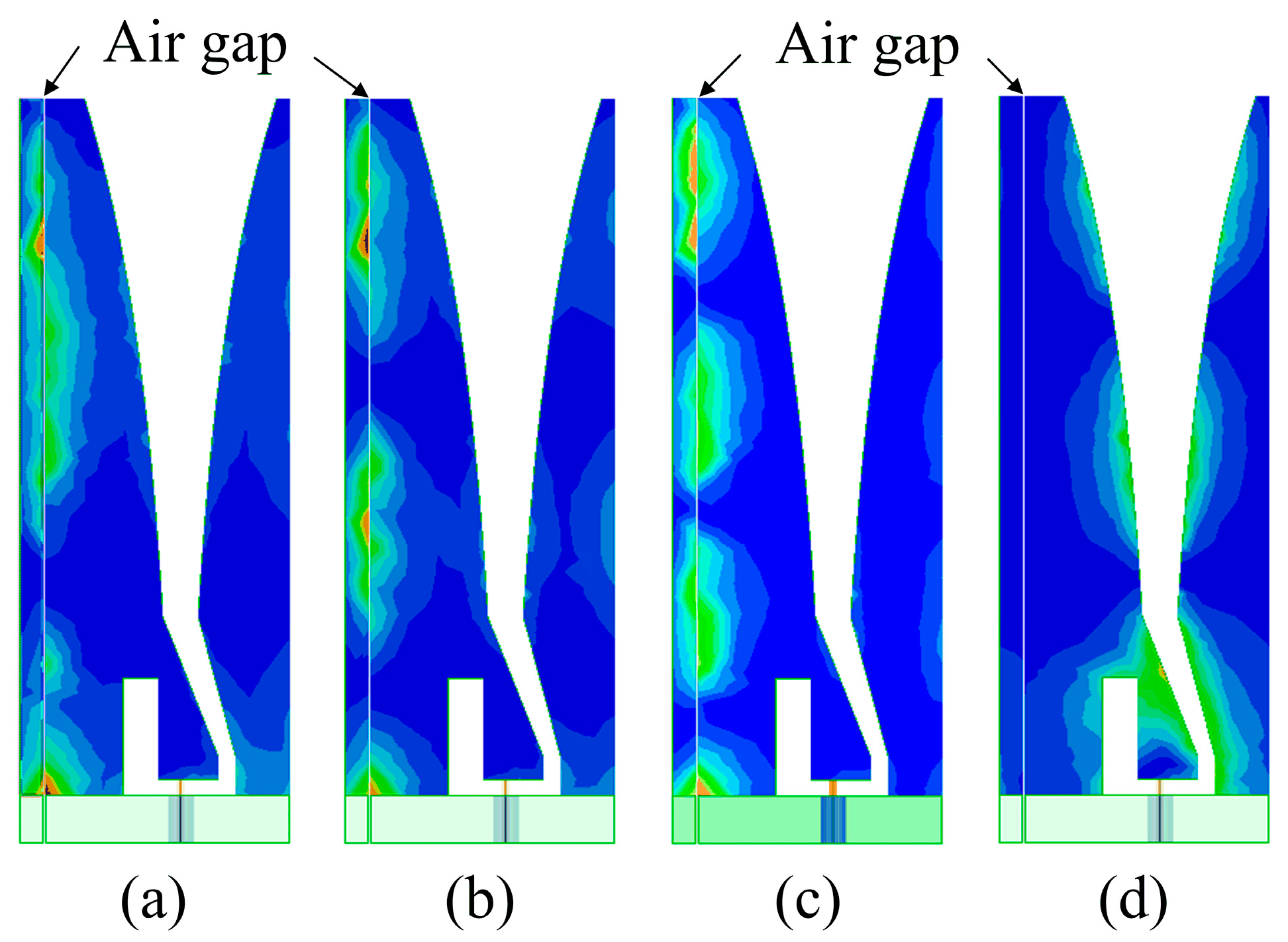


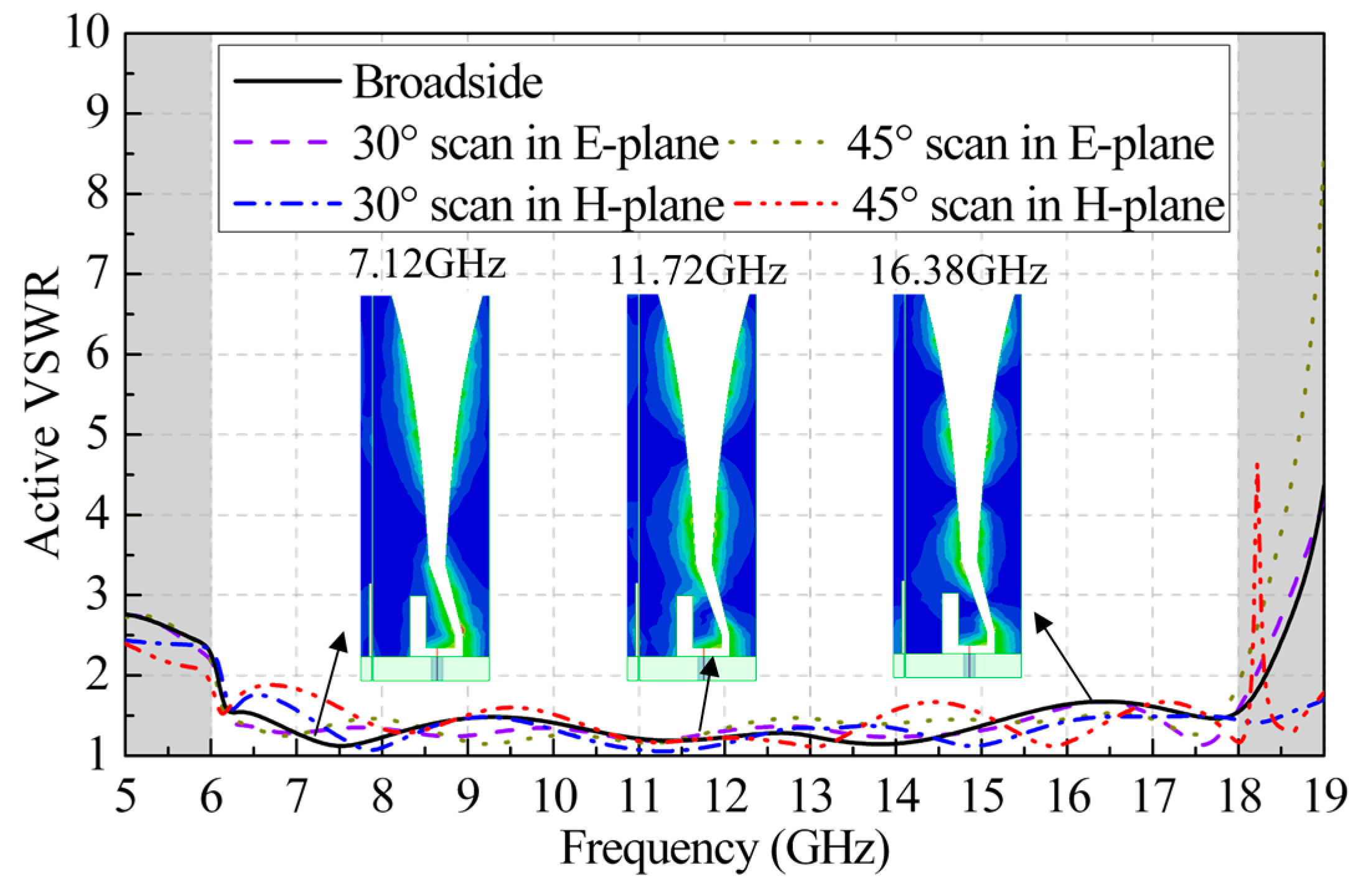




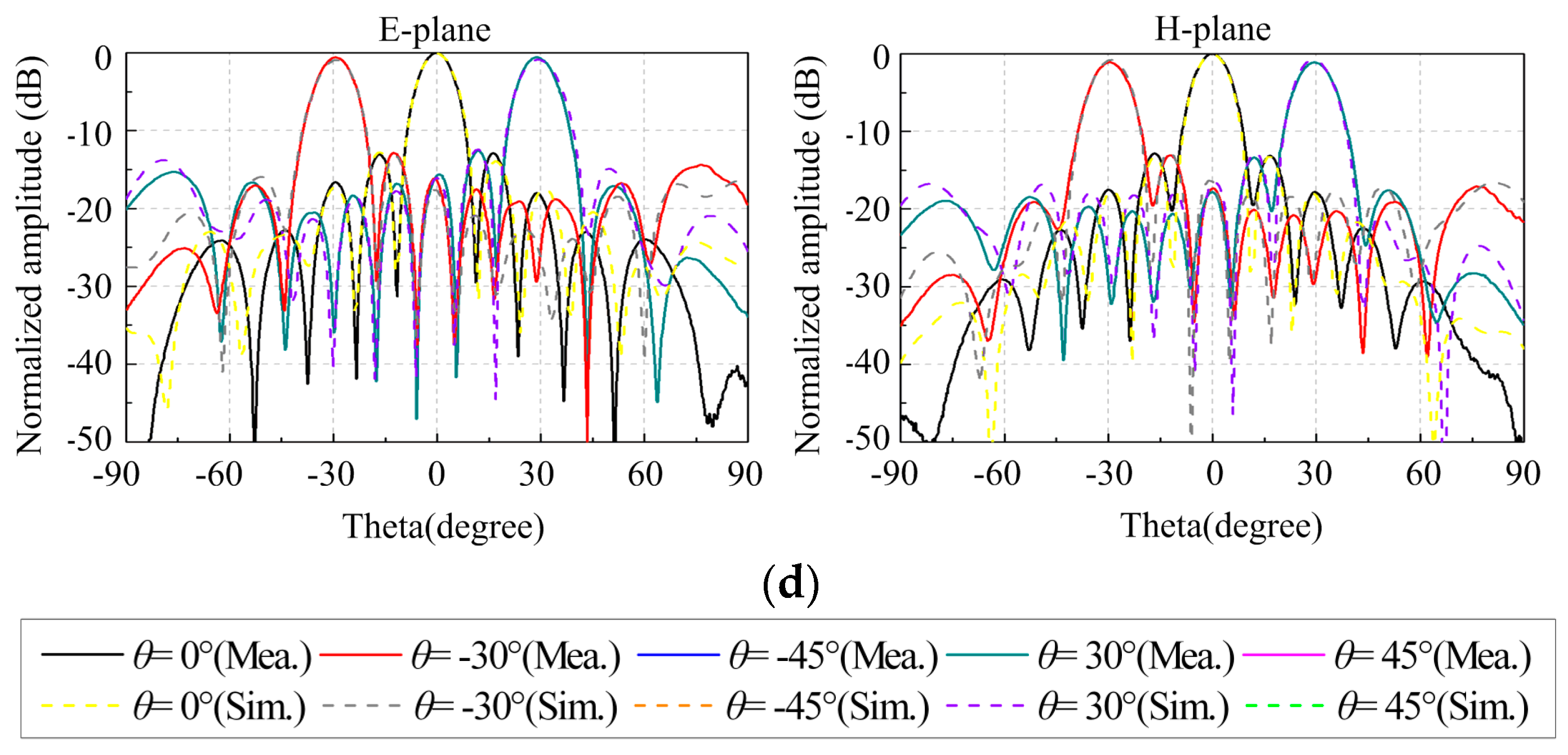
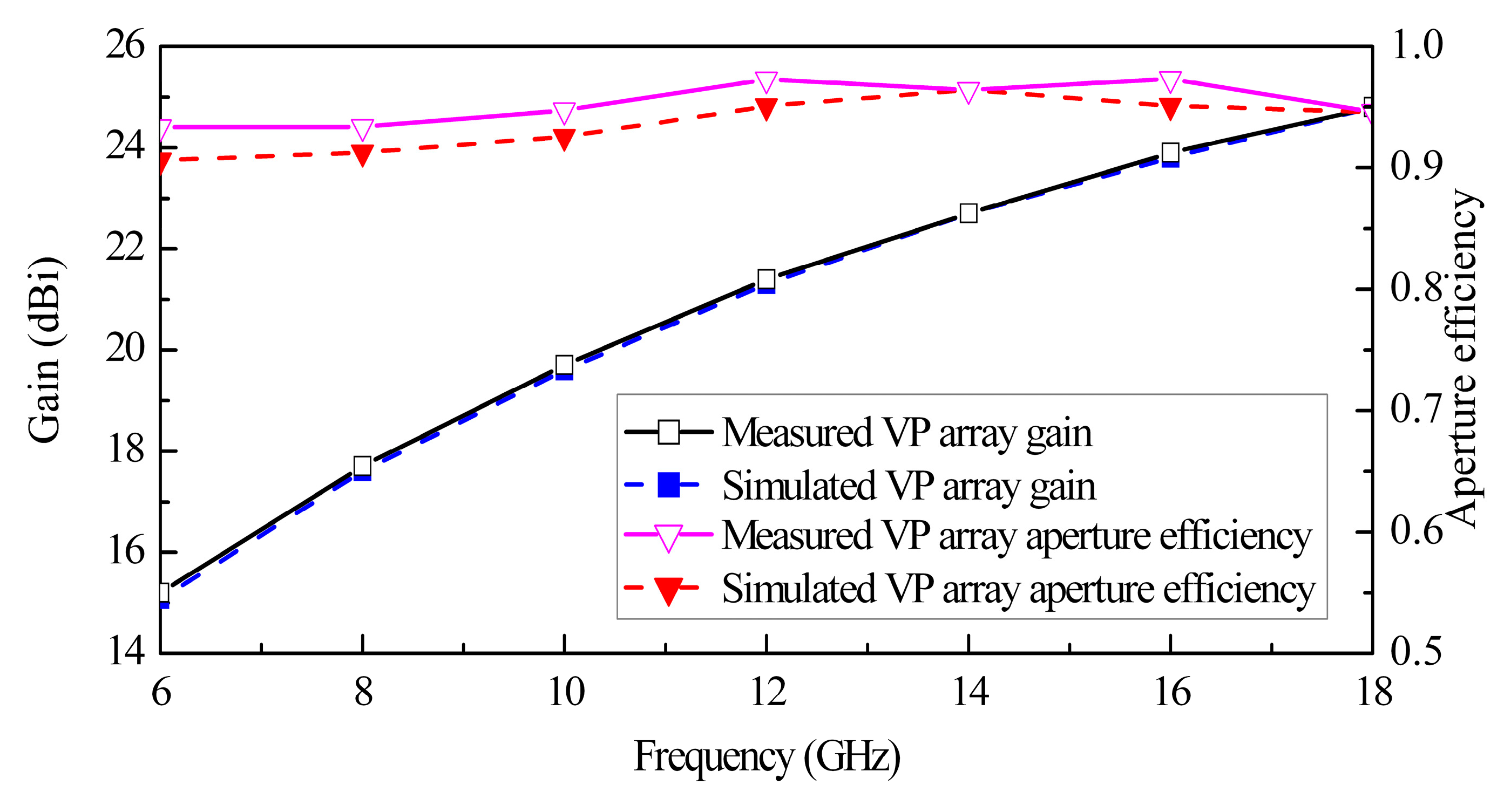
| Parameter | Value (mm) | Parameter | Value (mm) |
|---|---|---|---|
| h | 31.6 | h3 | 1.0 |
| w | 10.5 | w3 | 0.7 |
| h1 | 5.0 | h4 | 5.9 |
| w1 | 1.4 | w4 | 1.4 |
| h2 | 2.3 | d | 3.0 |
| w2 | 0.7 |
Disclaimer/Publisher’s Note: The statements, opinions and data contained in all publications are solely those of the individual author(s) and contributor(s) and not of MDPI and/or the editor(s). MDPI and/or the editor(s) disclaim responsibility for any injury to people or property resulting from any ideas, methods, instructions or products referred to in the content. |
© 2024 by the authors. Licensee MDPI, Basel, Switzerland. This article is an open access article distributed under the terms and conditions of the Creative Commons Attribution (CC BY) license (https://creativecommons.org/licenses/by/4.0/).
Share and Cite
Chen, B.; Wang, W.; Liu, J.; Ji, J. Dual-Polarized Metal Vivaldi Array Using Independent Structural Elements. Sensors 2024, 24, 315. https://doi.org/10.3390/s24020315
Chen B, Wang W, Liu J, Ji J. Dual-Polarized Metal Vivaldi Array Using Independent Structural Elements. Sensors. 2024; 24(2):315. https://doi.org/10.3390/s24020315
Chicago/Turabian StyleChen, Bo, Wei Wang, Juan Liu, and Jianmin Ji. 2024. "Dual-Polarized Metal Vivaldi Array Using Independent Structural Elements" Sensors 24, no. 2: 315. https://doi.org/10.3390/s24020315
APA StyleChen, B., Wang, W., Liu, J., & Ji, J. (2024). Dual-Polarized Metal Vivaldi Array Using Independent Structural Elements. Sensors, 24(2), 315. https://doi.org/10.3390/s24020315







